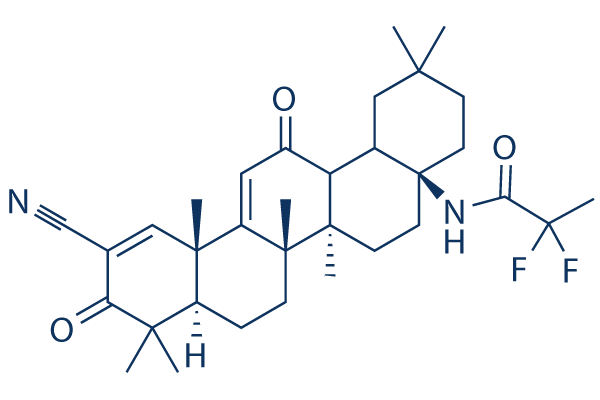| Description: |
RTA-408 is an antioxidant inflammation modulator (AIM), which activates Nrf2 and suppresses nitric oxide (NO). |
| Target: |
Nrf2[1] |
| In Vivo: |
To determine whether RTA-408 is an effective mitigator of hematopoietic acute radiation syndrome after bone marrow-lethal doses of total-body irradiation (TBI), mice are administered 3 daily injections of 17.5 mg/kg RTA-408 beginning 24 h after TBI. Teatment with RTA-408 results in the 35 day survival of 100% of 7 Gy (LD40/35) TBI mice (P<0.05) and 60% of 7.5 Gy (LD100/13) TBI mice (P<0.0001)[2]. |
| In Vitro: |
To evaluate the anti-inflammatory activity of RTA-408, RAW 264.7 mouse macrophage cells are treated with RTA-408 for two hours and then IFNγ is added to stimulate NO production and release into the media. RTA-408 dose-dependently reduces NO concentrations in the media with an IC50 value of 4.4±1.8 nM. The potency of RTA-408 in this assay is similar to that of Bardoxolone methyl, which has an IC50 value of 1.9±0.8 nM. Nrf2 activation is required for AIM-mediated NO suppression. A decrease in nitric oxide synthase 2 (Nos2) protein levels is observed in bardoxolone methyl-treated RAW 264.7 cells, which is attenuated when Nrf2 mRNA levels are reduced by siRNA. To evaluate the anticancer activity of RTA-408, a panel of eight human cell lines derived from tumors of different origin are treated with RTA-408 and measured cell growth 72 hours later using the sulforhodamine B (SRB) assay. RTA-408 inhibits the growth of all tumor lines with an average GI50 value of 260±74 nM. To determine whether RTA-408 induces apoptosis, the panel of tumor cells are treated with RTA-408 and the caspase substrate, DEVD-AFC, for 24 hours. RTA-408 dose-dependently increases DEVD-AFC cleavage, indicating that RTA-408 treatment triggers caspase activation in cancer cells. Caspase-3 and caspase-9 cleavage is also observed by western blot at the same concentrations of RTA-408 that increases DEVD-AFC cleavage[1]. |
| Cell Assay: |
MEFs, PANC-1, A549, A375, A549/NF-κB-Luc and HeLa/NF-κB-Luc cells are cultured in Gibco high glucose DMEM with 10% FBS. G-361 cells are cultured in McCoy’s 5A medium with 10% FBS. All other cell lines are cultured in RPMI 1640 medium with 10% FBS. For growth inhibition assays, cells are plated in duplicate 96-well culture dishes at 3×103 cells per well. The following day, one plate is treated with RTA-408 (200, 400, 600, 800 and 1000 nM) and the other is immediately processed for the sulforhodamine B (SRB) assay (time 0). Cells in the RTA-408-treated plate are processed for the SRB assay 72 hours after the start of treatment. Percentage of growth relative to vehicle-treated cells is calculated. Dose-response curves are plotted in GraphPad Prism and GI50 values are calculated. For cell counting experiments, MEFs are plated in 6-well culture dishes at 5×104 cells per well and treated with RTA-408 the following day. Following treatment, cells are counted using a Vi-CELL XR cell analyzer. For clonogenic assays, wild-type (1×103 cells per well) and Keap1-/- (0.5×103 cells per well) MEFs are seeded in 6-well dishes. Six hours later, MEFs are treated with RTA-408. After seven days, colonies are fixed with a 1:7 solution of acetic acid:MeOH and stained with 0.5% crystal violet in MeOH. Colonies consisting of ≥50 cells are counted[1]. |
| Animal Administration: |
Mice[2] For radiation survival experiments, wild-type C57Bl/6 CD45.2 mice (6-8 weeks old) are used. Congenic wild-type C57Bl/6 CD45.1 and C57Bl/6 CD45.1/CD45.2 hybrid host mice are used as recipients in transplantation experiments. RTA-408 stock solutions for vehicle control (DMSO) are prepared within 1 h before injection. RTA-408 (17.5 mg/kg) or DMSO is administered intraperitoneally at 24, 48 and 72 h after irradiation. Whole-body irradiation (7-8 Gy) is performed using a 250-kVp X-ray machine with 50 cm source-to-skin distance and a 2 mm copper filter. The dose rate is approximately 1.4 Gy/min. |
| References: |
[1]. Probst BL, et al. RTA 408, A Novel Synthetic Triterpenoid with Broad Anticancer and Anti-Inflammatory Activity. PLoS One. 2015 Apr 21;10(4):e0122942.
[2]. Goldman DC, et al. The triterpenoid RTA 408 is a robust mitigator of hematopoietic acute radiation syndrome in mice. Radiat Res. 2015 Mar;183(3):338-44
[3]. Peng Han, et al. RTA-408 Protects Kidney from Ischemia-Reperfusion Injury in Mice via Activating Nrf2 and Downstream GSH Biosynthesis Gene. Oxid Med Cell Longev. 24 December 2017. |






















